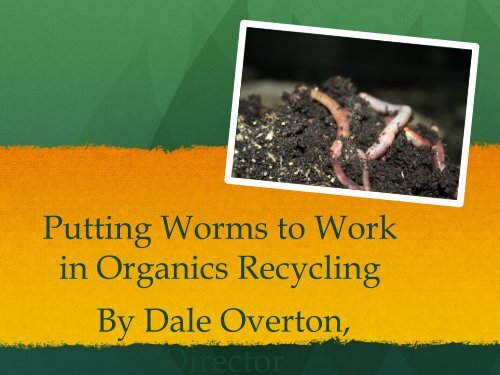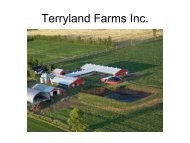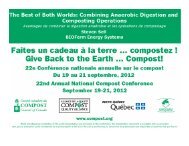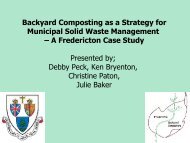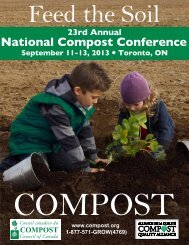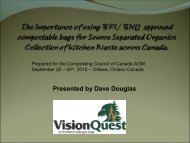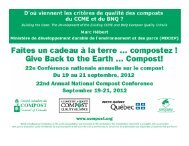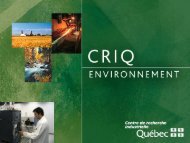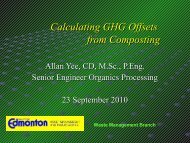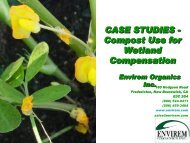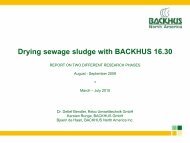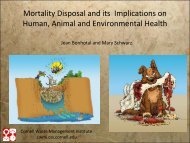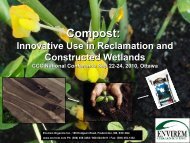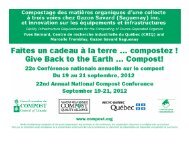Dale Overton, Overton Environmental Enterprises - Compost ...
Dale Overton, Overton Environmental Enterprises - Compost ...
Dale Overton, Overton Environmental Enterprises - Compost ...
You also want an ePaper? Increase the reach of your titles
YUMPU automatically turns print PDFs into web optimized ePapers that Google loves.
Putting Worms to Work<br />
in Organics Recycling<br />
By <strong>Dale</strong> <strong>Overton</strong>,<br />
Director
Overview<br />
1. Organic Waste Streams<br />
2. Vermitechnology – Putting Worms to Work<br />
3. Implementing Vermitechnology<br />
4. <strong>Environmental</strong> Considerations<br />
5. Equipment and Processing Techniques<br />
6. Worm Processing Flow Chart<br />
7. References
Organic Waste Streams<br />
1. Residential Waste<br />
- Kitchen scraps, paper products and yard waste<br />
(high Nitrogen content, moderate Carbon<br />
content)
Landfill Component Breakdown
Organic Waste Streams<br />
2. Commercial Waste<br />
- Restaurant waste<br />
(high Nitrogen content, low Carbon content)<br />
- Industrial food processing waste<br />
(high Nitrogen content, low Carbon content)<br />
- Pulp/paper and forestry waste<br />
(low Nitrogen content, high Carbon content)
Commercial Waste Streams<br />
Grocery store waste in a landfill<br />
Paper mill sludge in an tailings pond
Organic Waste Streams<br />
3. Agricultural Waste<br />
-<br />
Hay (low Nitrogen content, high Carbon content)<br />
-<br />
Green materials (high Nitrogen content, low Carbon content)<br />
-<br />
Manure (high Nitrogen content, low Carbon content)<br />
-<br />
Agricultural processing waste<br />
(high Nitrogen content, moderate Carbon content)
Agricultural Waste Streams<br />
Manure being composted with hay<br />
Old rotting hay bales that little the rural<br />
landscape
Click icon to add picture<br />
4. Municipal Biosolids Waste<br />
-<br />
High Nitrogen content and moderate Carbon content<br />
-<br />
High levels of other compounds<br />
(pharmaceuticals, antibiotics and toxic metals)
Current Organic Waste<br />
Handling Methods<br />
1. Land filling – The majority of organic waste is being<br />
buried in landfills across the world<br />
2. Burning – Many rural landfill operators and other<br />
industries burn organic matter to make room for more<br />
waste in landfills/waste compounds<br />
3. <strong>Compost</strong>ing – Fortunately, many cities in Europe,<br />
United States and Canada have implemented<br />
municipal composting programs
Vermitechology<br />
Putting Worms to Work in Organics<br />
Recycling<br />
Vermitechnology – The use of surface and subsurface local<br />
varieties of earthworms in composting and soil management<br />
(Ansari and Ismail, 2009)
Why Vermitechnology?<br />
- “Earthworms are the intestines of the earth and<br />
restoring agents of the soil” Aristotle – 382 – 322 BC<br />
- Earthworms process all forms of organic matter<br />
- Earthworms promote the growth of beneficial soil<br />
organisms<br />
- Earthworms recycle and stabilize nutrients effectively<br />
and efficiently
Benefits of Vermitechnology<br />
- Worms “mechanically” mix and aerate organic debris piles<br />
- Worms are robust and can handle a wide variety of waste<br />
streams<br />
- Worms can process large quantities of waste in a short time
Benefits of Vermitechnology<br />
- Worms can process up to 2x their weight in food per day<br />
- Low long term operational costs<br />
- Create a stable low cost, slow release organic fertilizer
Where can<br />
Vermitechnology be Used?<br />
- Residentially – Household organic waste reduction<br />
- Municipally – Landfill composting operations and<br />
management of biosolids waste<br />
- Commercially – Food service and food processing facilities<br />
- Agriculturally – Manure, green waste and hay management
Implementing<br />
Vermitechnologies
Earthworms are Livestock<br />
- Worms are a form of livestock<br />
- In cold climates worms must be reared indoors during<br />
winter months (or year round)<br />
- Worms require maintenance<br />
(watering, feeding, bedding and breeding)
What Species are Best?<br />
Native local earthworms are the best choice if suited for<br />
composting<br />
1. Tropical and sub tropical climates<br />
ü<br />
ü<br />
ü<br />
ü<br />
African Night Crawler – Eudrilus eugeniae<br />
Tiger Worms – Eisenia andreia<br />
Indian Blue Worm – Perionyx excavatus<br />
Other local worms
What Species are Best?<br />
2. In Northern climates the two most common species for<br />
composting include<br />
ü<br />
ü<br />
ü<br />
Red Wiggler – Eisenia foetida<br />
European Night Crawler – Eisenia hortensis<br />
Canadian Night Crawler – Lumbricus terrestris
<strong>Environmental</strong> Considerations<br />
1. Temperature<br />
ü Most worms are most active between 5 and 25<br />
degrees<br />
2. Bedding<br />
ü<br />
ü<br />
Bed construction very important<br />
Base materials – peat, coco choir, soil, hay, compost
<strong>Environmental</strong> Considerations<br />
3. pH – Potential Hydrogen<br />
ü<br />
ü<br />
ü<br />
Greatly affects nutrient chemistry and transfer in<br />
soil systems<br />
Important for all aspects of worm development<br />
and reproduction<br />
Neutral pH (6.5-7.5) promotes the highest<br />
fecundity and growth rates of earthworms
<strong>Environmental</strong> Considerations<br />
4. Moisture<br />
ü<br />
Bedding should be kept between 70-75% moisture<br />
for optimum growth<br />
5. Feedstock<br />
ü<br />
ü<br />
Vegetable and other food waste, grain, manure,<br />
biosolids, leaf little and other highly abundant<br />
waste streams<br />
Feedstock should contain 17% protein for optimal<br />
growth and reproduction
Other Considerations<br />
Reproduction<br />
ü<br />
Earthworms can reproduce at high rates if<br />
conditions allow<br />
ü<br />
Earthworms reach sexual maturity between 28-<br />
95 days<br />
Cycles<br />
ü<br />
ü<br />
Understand the growth patterns of worms<br />
Keep immature and mature worms separated
Reproductive Capacity of<br />
Useful Species<br />
Table 1 – Describing the reproductive capacity of three common composting worms<br />
Species<br />
Sexual<br />
Maturity<br />
Time<br />
(days)<br />
No. 0f<br />
Cocoons<br />
Cocoon<br />
Hatching<br />
Time<br />
(days)<br />
Egg<br />
Maturit<br />
y<br />
(days)<br />
Hatching<br />
Success<br />
(%)<br />
No. of<br />
offspr<br />
ing<br />
Net<br />
reprorate/<br />
week<br />
E. Fetida 53-76 3.8 32-73 85-149 83.2 3.3 10.4<br />
E.<br />
eugeniae<br />
P.<br />
excavatus<br />
32-95 3.6 13-27 43-122 81 2.3 6.7<br />
28-56 19.5 16-21 44-71 90.7 1.1 19.4<br />
D. veneta 57-86 1.6 40-126 97-214 81.2 1.1 1.4<br />
Credit – Sinha et al. - 2009
Vermicompost/Castings<br />
ü<br />
ü<br />
ü<br />
Vermicompost (castings) is the end material excreted by<br />
earthworms<br />
It is a fertilizer and soil conditioner of the highest value<br />
(2 - 3.5% N, 1.5 - 2% P, 1 - 1.5% K plus micronutrients)<br />
It contains many varieties of plant growth promoting<br />
microbes
Vermicompost/Castings<br />
ü<br />
ü<br />
ü<br />
It contains enzymes and plant growth regulators<br />
(hormones)<br />
It replaces chemical fertility and restores soil health<br />
It reduces disease and environmental stress
Growth Trial Example<br />
12<br />
10<br />
8<br />
6<br />
4<br />
2<br />
0<br />
Chart 1 – The growth and development of Okra plants in a potted<br />
experiment. Results obtained after 120 days of growth. Earthworms (EW),<br />
Vermicompost (VC), Synthetic Fertilizer (NPK-Fert), control. Credit – Sinha<br />
et al. - 2009
Markets<br />
ü Retail<br />
ü Agricultural<br />
ü Land Reclamation<br />
ü Landscape Management
Worm Processing Flow Chart
Processing Equipment and<br />
Facility Requirements<br />
Worm housing and processing equipment are vital to a<br />
vermitechnology operation<br />
- Housing should allow for easy maintenance and<br />
processing<br />
- Processing equipment should include screening and<br />
separation of castings, eggs and large worms<br />
- Batch mixer to blend bedding constituents
<strong>Overton</strong> <strong>Environmental</strong><br />
<strong>Enterprises</strong> Operation
The Harbingers of Life in<br />
the Soil
References<br />
Ansari A. A. 2008. Effect of Vermicompost on the<br />
Productivity of Potato (Solanum tuberosum), Spinach<br />
(Spinacia oleracea) and Turinp (Brassica campestris).<br />
World of Agri. Sci. 4(3) 333-336<br />
Darwin C. 1881. The Fermentation of Vegetable<br />
Moulds Through the Action of Worms. Murray<br />
Publications London<br />
Sinha R.K., Heart S., Valani D. and Chauhan K. 2009.<br />
Vermiculture and Sustainable Agriculutre. Am-Euras.<br />
J. Agric & Environ. Sci. 5(S) 01-55.


